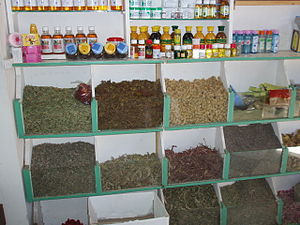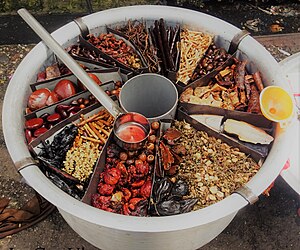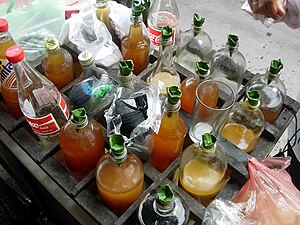Herbal medicine/ja: Difference between revisions
Created page with "===アメリカ=== アメリカ先住民は、北米に自生する約20,000種の植物のうち、約2,500種を利用していた。" |
Created page with "インドのアーユルヴェーダの影響を受けている可能性はあるが、インドネシア群島にはインドにはない固有の植物が数多くあり、ウォレス・ラインを越えたオーストラリアにも似た植物がある。ジャムーの慣習は地域によって異なることがあり、特に国内の遠隔地では記録されていないことが多い..." |
||
| (4 intermediate revisions by the same user not shown) | |||
| Line 114: | Line 114: | ||
アメリカ先住民は、北米に自生する約20,000種の植物のうち、約2,500種を利用していた。 | アメリカ先住民は、北米に自生する約20,000種の植物のうち、約2,500種を利用していた。 | ||
[[:en:Andes|アンデス]]のヒーリングでは、[[Entheogen/ja|エンセオゲン]]、特にサンペドロサボテン(''[[Echinopsis pachanoi/ja|エキノプシス・パチャノイ]]'')の使用は今でも重要な要素であり、何千年も前から存在している。 | |||
===中国=== | |||
西洋医学と[[traditional Chinese medicine/ja|伝統中国医学]]の両方の訓練を受けた研究者の中には、現代科学に照らして古代の医学書を解体しようと試みた者もいる。1972年、製薬化学者であるトゥー・ユーユーが、[[sweet wormwood/ja|甘蓬]]から抗マラリア薬物[[artemisinin/ja|アルテミシニン]]を抽出した。 | |||
===インド=== | |||
=== | [[File:Herbal medicine platter.jpg|thumb|インド・ゴアの本草学大皿]] | ||
[[File:Herbal medicine platter.jpg|thumb| | インドでは、[[Ayurvedic medicine/ja|アーユルヴェーダ医学]]には30以上の成分を含むかなり複雑な処方があり、その中には[[dosha/ja|ドーシャ]]のバランスを取るために選ばれた「[[:en:alchemy|錬金術加工]]」を経た成分も相当数含まれている。ラダック、ラフル・スピティ、チベットでは、「アミチ医学体系」とも呼ばれる[[Tibetan Medicine/ja|チベット医学体系]]が普及している。337種以上の[[medicinal plant/ja|薬用植物]]が[[:en:C.P. Kala|C.P. Kala]]によって記録されている。それらはこの医療システムの実践者であるアムチによって使用されている。インドの書物『ヴェーダ』には、植物による病気の治療について言及されている。 | ||
===インドネシア=== | |||
== | [[File:Jamu.jpg|thumb|right|瓶に入れられたインドネシアの[[jamu/ja|ジャムー]]生薬の種類]] | ||
[[File:Jamu.jpg|thumb|right| | [[:ja:インドネシア|インドネシア]]、特に[[:en:Javanese people|ジャワ人]]の間では、[[jamu/ja|ジャムー]]という伝統的な本草学は、1300年ほど前の[[:en:Mataram Kingdom|マタラム王国]]の時代に生まれたと考えられている。[[:en:Borobudur|ボロブドゥール]]の[[:en:bas-relief|浮き彫り]]には、石の[[:en:mortar and pestle|臼と乳棒]]で薬草を挽く人々、酒売り、薬草師、[[:en:masseuse|マッサージ師]]が人々を治療する姿が描かれている。[[:en:Majapahit|マジャパヒト]]時代のマダワプラ碑文には、''Acaraki''と呼ばれる薬草調合師(ハーバリスト)という特定の職業が記されている。1700年頃の[[:en:Mataram Sultanate|マタラム]]の書物には3,000のジャムウ・ハーバル・レシピが記載されており、ジャワ古典文学[[:en:Serat Centhini|Serat Centhini]] (1814)にはいくつかのジャムウ・ハーバル調合レシピが記載されている。 | ||
インドの[[Ayurveda/ja|アーユルヴェーダ]]の影響を受けている可能性はあるが、[[:en:List of islands of Indonesia|インドネシア群島]]にはインドにはない固有の植物が数多くあり、[[:en:Wallace Line|ウォレス・ライン]]を越えたオーストラリアにも似た植物がある。ジャムーの慣習は地域によって異なることがあり、特に国内の遠隔地では記録されていないことが多い。主に薬草であるが、[[honey/ja|蜂蜜]]、[[royal jelly/ja|ローヤルゼリー]]、牛乳、''[[ayam kampung/ja|アヤム・カンプン]]''[[chicken eggs/ja|卵]]などの動物から得られるジャムーの材料もある。 | |||
==信念== | ==信念== | ||
Latest revision as of 15:48, 17 March 2024
| この記事は、下記シリーズの一部分 |
| Alternative medicine/ja |
|---|
 |

本草学(ほんぞうがく、herbal medicine, herbalism)とは、伝統医学の基礎となる生薬学と薬用植物の利用の学問である。世界的な薬理学の研究により、アルテミシア・アンヌア(漢方では解熱薬として知られていた薬草)から単離されたアルテミシニンと呼ばれる抗マラリア薬物のように、本草学が現代薬に転用されたものもある。21世紀の本草学で使用される植物の安全性と有効性に関する科学的根拠は限られており、一般的に純度や用量の基準は示されていない。本草学の範囲には、一般的に菌類や蜂の産物、鉱物、貝殻、特定の動物の部位が含まれる。本草学は植物医学または植物療法とも呼ばれる。
パラハーバリズム (Paraherbalism)とは、代替医療や疑似科学において、精製されていない植物や動物のエキスを、実証されていない医薬品や健康増進剤として使用することを指す。パラハーバリズムは、より少ない加工で特定の供給源から様々な物質を保存することは、製造された製品よりも安全であるか、より効果的であるという信念に依存しているが、この概念には根拠がない。
歴史

考古学的証拠によれば、薬用植物の使用は約6万年前の旧石器時代にまでさかのぼる。薬草療法の文字による証拠は5,000年以上前のシュメール人に遡り、彼らは植物のリストをまとめた。いくつかの古代文化では、薬草書と呼ばれる書物に植物とその医療用途について書かれている。古代エジプトでは、ハーブはエジプト医学パピルスに記載されていたり、墓の挿絵に描かれていたり、まれに微量のハーブが入った医療用の壺から発見されたりする。古代エジプトのエベルス・パピルスは紀元前1550年頃のもので、主に植物由来の700以上の化合物を扱っている。最古のギリシア語の薬草書は、紀元前4世紀にギリシア語で著したエレソスのテオフラストスのHistoria Plantarum、紀元前3世紀に著したカリストスのディオクレス、紀元前1世紀に著したクラテュアスのものである。これらの著作の断片はわずかしか残っていないが、残っているものから、学者たちはエジプトの本草書との重複を指摘した。薬草学に用いられたと思われる種子が青銅器時代の中国の遺跡から発見された。中国の殷王朝(紀元前1600〜1046年頃)の遺跡から、薬草学に用いられたと思われる種子が発見された。中国初期の医学書である『黄帝内経』に記載されている224種類の化合物のうち100種類以上が医薬品である。ハーブは古代インドの伝統医学でもよく使われており、そこでは病気の主な治療法は食事療法であった。アナザルバス キリキア,ペダニウス・ディオスコリデス(紀元後40-90年頃)がギリシャ語で書いたデ・マテリア・メディカは、医師であり植物学者であったが、1600年代まで何世紀にもわたって使用された薬草書の一例である。
現代の本草学
世界保健機関(WHO)の推計によれば、現在、アジアやアフリカのいくつかの国では、人口の80%がプライマリーヘルスケアのために本草学を利用している。
処方薬の中には、アルテミシニン、ジギタリス、キニーネ、タキサンなど、漢方薬としての基礎を持っているものもある。
規制の見直し
2015年、オーストラリア保健省は、代替療法が健康保険の適用に適しているかどうかを判断するためのレビュー結果を発表した。ハーブ製品の安全性と有効性を評価するためのガイドラインを確立するために、欧州医薬品庁は2017年にハーブ製品に関するモノグラフを作成する際の臨床研究の質を評価・格付けするための基準を示した。米国では、国立衛生研究所の国立補完統合医療センターがハーブ化合物の臨床試験に資金を提供し、多くの植物源の安全性、潜在的有効性、副作用を評価するファクトシートを提供し、ハーブ製品について実施された臨床研究の登録簿を管理している。
2015年時点の英国がん研究によれば、「ハーブ療法ががんを治療、予防、治癒できるという強力な証拠は、現在のところ人を対象とした研究からは得られていない」という。
使用頻度
漢方薬の使用は、がん、糖尿病、喘息、末期腎臓病などの慢性疾患を持つ人々により多くみられる。また、性別、年齢、民族性、教育、社会階層といった複数の要因が、漢方薬の使用率と関連していることが示されている。
ハーブの調合

ハーブの投与には多くの形態があるが、最も一般的なものはハーブティーや(場合によっては希釈された)植物エキスとして飲用される液体である。
ハーブティーまたはティサンは、ハーブを水に抽出した結果の液体であるが、いくつかの異なる方法で作られる。煎じ薬はカモミールやミントなどのハーブを蒸すことによって熱水抽出したものである。煎じ薬は、通常は根や樹皮のような硬い物質を長時間煮出したエキスである。マセラシオンはセージやタイムのような粘液を多く含む植物の冷煎である。マセラートを作るには、植物を刻んで冷水に加える。その後、7~12時間放置する(使用するハーブによって異なる)。ほとんどのマセレートには10時間が使われる。
チンキ剤はハーブのアルコール抽出物で、一般にハーブティーよりも強い。チンキ剤は通常、純粋なエタノール(または純粋なエタノールと水の混合物)をハーブと組み合わせることで得られる。完成したチンキ剤は、エタノールの割合が少なくとも25%(最大90%の場合もある)である。ノンアルコール・チンキはグリセリンで作ることができるが、アルコールベースのチンキよりも体内への吸収率が低く、保存期間が短いと考えられている。ハーブワインとエリキシルはハーブのアルコール抽出物で、通常エタノールの割合は12~38%である。エキスには液体エキス、乾燥エキス、ネブライザーがある。液体エキスはチンキ剤よりもエタノール率が低い液体である。それらは通常、真空蒸留チンキによって作られる。乾燥エキスは、乾燥した塊に蒸発させた植物材料の抽出物である。その後、さらに精製してカプセルや錠剤にすることができる。
ハーブ製品の正確な組成は抽出方法に影響される。水は極性溶媒であるため、お茶には極性成分が豊富に含まれる。一方、油は非極性溶媒であり、非極性化合物を吸収する。アルコールはその中間に位置する。

多くのハーブは様々な形で皮膚に局所的に適用される。エッセンシャルオイルエキスは、通常キャリアオイルで希釈して皮膚に塗布することができる。多くのエッセンシャルオイルは皮膚を火傷させたり、単純にそのまま使用するには量が多すぎる。オリーブオイルやアーモンドオイルのような食品グレードのオイルで希釈することで、外用薬として安全に使用することができる。軟膏オイル、香油、クリーム、ローションは、局所投与メカニズムの他の形態である。ほとんどの外用剤はハーブのオイル抽出物である。食品グレードのオイルにハーブを数週間から数ヶ月浸すと、特定の植物化学物質がオイルに抽出される。このオイルは、軟膏やクリーム、ローションにしたり、単に外用オイルとして使うことができる。多くのマッサージオイル、抗菌性軟膏、創傷治癒剤はこの方法で作られている。
安全性

ハーブの摂取は副作用を引き起こす可能性がある。さらに、"不純物の混入、不適切な処方、植物と薬物の相互作用の理解不足が、時には生命を脅かしたり、死に至らしめるような副作用を引き起こしている"。医薬品として使用する前に、それぞれの植物の安全性と有効性を判断するために、適切な二重盲検臨床試験が必要である。
多くの消費者は、本草学は自然のものだから安全だと信じているが、本草学と合成薬物は相互作用し、消費者に毒性を引き起こす可能性がある。また、本草学は危険なほど汚染されていることもあり、有効性が確立されていない本草学が、知らず知らずのうちに処方薬の代わりに使われていることもある。
米国では純度や用量の標準化は義務付けられていないが、同じ規格で作られた製品でも、植物種内の生化学的変異の結果、異なる場合がある。植物には捕食者に対する化学的防御機構があり、それが人体に悪影響を与えたり、致死的な影響を与えたりすることがある。毒性の強いハーブの例としては、ウルシやナイトシェードがある。ヨーロッパでは「魔術」「呪術」「陰謀」と結びついた長く華やかな歴史があることもあり、その危険性はよく知られているため、一般にハーブとして販売されることはない。頻繁ではないが、広く使用されているハーブについては副作用が報告されている。時には、ハーブの摂取と関連して、重篤な不測の事態が起こることもある。慢性的な甘草の摂取が原因でカリウムが大量に減少した事例があり、そのため、プロのハーバリストは、リスクがあると認識した場合には甘草の使用を避けている。ブラックコホシュは肝不全に関与している。 妊娠中の女性に対するハーブの安全性に関する研究はほとんどない。ある研究では、補完代替医薬品の使用は、不妊治療中の妊娠継続率および生児出生率を30%低下させるという結果が出ている。
有害事象と因果関係があると思われるハーブ療法の例としては、アコナイト(これはしばしば法的に制限されたハーブである)、アーユルヴェーダ療法、ブルーム、チャパラル、漢方薬混合物、コンフリー、特定のフラボノイドを含むハーブ、ゲルマンダー、グァーガム、甘草の根、ペニーロイヤルなどがある。長期的な副作用をもたらす可能性のあるハーブの例としては、朝鮮人参、絶滅危惧種のハーブ金ニンジン、ミルクシスル、センナ(ハーバリストは一般にこれを勧め、めったに使用しない)などがある、 アロエベラジュース、バックソーン樹皮と果実、カスカラサグラダ樹皮、ノコギリヤシ、バレリアン、カヴァ(EUでは禁止されている)、セイヨウオトギリソウ、カト、檳榔子、制限ハーブエフェドラ、ガラナなどがある。
また、ハーブと薬物の相互作用が数多く確立されていることに関しても懸念がある。実際の処方薬やその他の医薬品の消費量を顧客がハーブ専門医に知らせる必要があるのと同様に、いくつかのハーブ療法は、様々な処方薬や市販医薬品と組み合わせて使用すると、有害な薬物相互作用を引き起こす可能性があるため、医師と相談しながら、ハーブ療法の使用法を明らかにすべきである。
例えば、血圧を下げる本草学と同じ効果を持つ処方薬を併用することで、危険な低血圧になることがある。ハーブの中には抗凝固剤の効果を増幅させるものもある。 ある種のハーブや一般的な果物は、多くの薬物代謝に重要な酵素であるシトクロームP450を阻害する。
2018年の調査で、FDAは「ハーブ」「ナチュラル」「伝統的」として販売された700以上の分析済み栄養補助食品から、活性のある医薬品添加物を特定した。未公表の添加物には、「未承認の抗うつ剤やデザイナーズ・ステロイド」のほか、シルデナフィルやシブトラミンなどの処方薬も含まれていた。
ラベル表示の正確さ
2013年の調査では、サンプリングされたハーブサプリメントの3分の1が、ラベルに記載されたハーブの痕跡を含んでいないことが判明した。この研究では、大豆、小麦、ブラックウォールナットなどの潜在的なアレルゲンを含む、ラベルに記載されていない汚染物質や充填剤が混入した製品が発見された。セント・ジョーンズ・ワートと表示されたボトルの中には、実際には下剤であるアレキサンドリア・センナが含まれていることが判明した。
アデレード大学の研究者たちが2014年に発見したところによると、販売条件であるにもかかわらず、調査対象となったハーブ療法のほぼ20パーセントが治療用品管理局に登録されていなかった。また、調査対象となった製品の60%近くが、ラベルに記載されているものと一致しない成分を含んでいた。121の製品のうち、TGAのリストとパッケージが一致する成分があったのはわずか15であった。
2015年、ニューヨーク検事総長は、誤ったラベルが貼られ、潜在的に危険なハーブサプリメントを販売していたとして告発された米国の大手小売業者4社(GNC、Target、Walgreens、Walmart)に販売停止命令の書簡を出した。調査の一環として24の製品がDNAバーコーディングによって検査され、5つを除くすべての製品が製品ラベルと一致しないDNAを含んでいた。
ハーバリズムの実践者たち

いくつかの国では、ハーバリストのための正式な訓練と最低教育基準が存在するが、これらは必ずしも国内または国間で統一されていない。例えば、オーストラリアでは、ハーバルセラピストという職業が自主規制されているため(2009年現在)、トレーニングの基準がまちまちであり、多数の緩やかに結成された協会が異なる教育基準を設定している。2009年のあるレビューでは、本草学と処方医薬品との相互作用のリスクを減らし、臨床ガイドラインと本草学製品の処方を実施し、公衆衛生と安全を守るための自主規制を保証するために、オーストラリアにおける本草学者の規制が必要であると結論づけた。イギリスでは、ハーバリストの養成は、本草学の理学士号を授与する国費大学によって行われている。米国では、米国ハーバリストギルドによると、"現在、どの州でもハーバリストの免許や資格はなく、誰でもハーブを使用、調剤、推奨する権利を排除している"という。しかし、ハーブを治療薬として医薬品として販売したり、実質的に無免許の医師として活動したりすることには、米国連邦政府による規制がある。
米国のハーバリズム詐欺
2017年から21年にかけて、米国食品医薬品局(FDA)は、そのような証拠が存在しないにもかかわらず、「疾病の診断、治癒、緩和、治療、または予防における使用を意図しているため、および/または身体の構造または何らかの機能に影響を及ぼすことを意図しているため、法201条(g)(1)[合衆国法典第21編第321条(g)(1)]に基づく薬物であることを引き起こす条件」で製品を違法に販売しているとして、多数のハーバリズム企業に対して警告書を発行した。COVID-19パンデミックの際、FDAと米国連邦取引委員会は、ハーブ製品がCOVID-19病を予防または治療できるという虚偽の主張を宣伝したとして、数百のアメリカ企業に警告を出した。
政府の規制
世界保健機関(WHO)は、国際的な公衆衛生に関わる国連(UN)の専門機関であるが、1998年に薬用植物原料の品質管理法を発表し、WHO加盟国が本草学の品質保証と管理の全体的な文脈の中で、本草原料の品質基準と規格を確立することを支援している。
欧州連合(EU)では、本草学はハーブ医薬品委員会の下で規制されている。
米国では、ハーブ療法は食品医薬品局(FDA)によって、栄養補助食品の現行の適正製造規範(cGMP)方針の下で規制されている。このカテゴリーに分類される製品の製造業者は、「医学的」な主張をしたり、「栄養補助食品」以外の用途を示唆したりしない限り、製品の安全性や有効性を証明する必要はないが、有害性が証明された場合には、FDAは製品の販売を取りやめることがある。
カナダの規制は、自然・非処方保健製品局によって説明されており、認可された本草学や栄養補助食品のラベルには、8桁の自然製品番号またはホメオパシー薬番号の記載が義務付けられている。
ハーブの中には大麻やコカのように、ほとんどの国で全面的に禁止されているものもあるが、コカは栽培されている南米諸国のほとんどでは合法である。大麻植物はハーブ医学として使用されるため、世界の一部では合法である。2004年以降、栄養補助食品としてのエフェドラの販売は、アメリカではFDAによって禁止されており、イギリスではスケジュールIIIの規制対象となっている。
科学的批判
ハーバリズムは、信頼できない製品の品質、安全性の危険性、誤解を招く健康アドバイスの可能性など、潜在的な「地雷原」として批判されてきた。世界的に見ても、様々なハーブ製品の内容、安全性、有効性を認証する基準はなく、一般的に製品の成分や抗疾患活性の有効性に関する質の高い科学的研究は存在しない。有効性と安全性の厳密な証拠がないまま、ハーブ製品から治療効果があると推定される主張は、科学者から懐疑的な見方を受けている。
一部のハーバリストや製造業者による非倫理的行為には、製品のラベルや文献に健康上の利点について虚偽の広告を記載したり、製品の調製時に充填剤を混入したり使用したりすることが含まれる場合があり、サービスや製品に対する消費者の信頼を損なう可能性がある。
パラハーバリズム

パラハーバリズム(Paraherbalism)とは、植物または動物由来のエキスを医薬品または健康増進剤として疑似科学的利用することである。植物療法が標準的な薬理学における植物由来の医薬品と異なるのは、生物学的に活性であると考えられる植物からの化合物を単離し、標準化しないからである。植物療法は、より少ない処理で特定の植物からの物質の複雑さを保持することがより安全で、より効果的である可能性があるという誤った信念に依存している。
植物化学の研究者であるヴァロ・ユージーン・タイラーは、パラハーバリズムを「偽科学に基づく欠陥のある、あるいは劣ったハーバリズム」と表現し、科学的な用語を使っているが、安全性と効能に関する科学的な証拠が欠けているとした。タイラーは、ハーバリズムとパラハーバリズムを区別する10の誤謬を挙げた。その中には、安全で効果的なハーブを弾圧する陰謀がある、ハーブは害を引き起こすことはない、ハーブ全体は植物から分離された分子よりも効果的である、ハーブは薬物よりも優れている、などの主張が含まれる、 シグネチャーの教義(植物の形状がその機能を示すという信念)は有効であり、物質の希釈は効力を増大させる(ホメオパシーという疑似科学の教義)、占星術の配置は重要であり、人体への影響を示すのに動物実験は適切ではなく、逸話的証拠は物質が効くことを証明する効果的な手段であり、ハーブは病気を治すために神によって創造された。タイラー氏は、これらの信念はどれも事実無根であることを示唆している。
伝統的なシステム

アフリカ
アフリカでは人口の80%までが一次医療として伝統医療を利用している。
アメリカ
アメリカ先住民は、北米に自生する約20,000種の植物のうち、約2,500種を利用していた。
アンデスのヒーリングでは、エンセオゲン、特にサンペドロサボテン(エキノプシス・パチャノイ)の使用は今でも重要な要素であり、何千年も前から存在している。
中国
西洋医学と伝統中国医学の両方の訓練を受けた研究者の中には、現代科学に照らして古代の医学書を解体しようと試みた者もいる。1972年、製薬化学者であるトゥー・ユーユーが、甘蓬から抗マラリア薬物アルテミシニンを抽出した。
インド

インドでは、アーユルヴェーダ医学には30以上の成分を含むかなり複雑な処方があり、その中にはドーシャのバランスを取るために選ばれた「錬金術加工」を経た成分も相当数含まれている。ラダック、ラフル・スピティ、チベットでは、「アミチ医学体系」とも呼ばれるチベット医学体系が普及している。337種以上の薬用植物がC.P. Kalaによって記録されている。それらはこの医療システムの実践者であるアムチによって使用されている。インドの書物『ヴェーダ』には、植物による病気の治療について言及されている。
インドネシア

インドネシア、特にジャワ人の間では、ジャムーという伝統的な本草学は、1300年ほど前のマタラム王国の時代に生まれたと考えられている。ボロブドゥールの浮き彫りには、石の臼と乳棒で薬草を挽く人々、酒売り、薬草師、マッサージ師が人々を治療する姿が描かれている。マジャパヒト時代のマダワプラ碑文には、Acarakiと呼ばれる薬草調合師(ハーバリスト)という特定の職業が記されている。1700年頃のマタラムの書物には3,000のジャムウ・ハーバル・レシピが記載されており、ジャワ古典文学Serat Centhini (1814)にはいくつかのジャムウ・ハーバル調合レシピが記載されている。
インドのアーユルヴェーダの影響を受けている可能性はあるが、インドネシア群島にはインドにはない固有の植物が数多くあり、ウォレス・ラインを越えたオーストラリアにも似た植物がある。ジャムーの慣習は地域によって異なることがあり、特に国内の遠隔地では記録されていないことが多い。主に薬草であるが、蜂蜜、ローヤルゼリー、牛乳、アヤム・カンプン卵などの動物から得られるジャムーの材料もある。
信念
ハーバリストは、植物の根や葉などの部分から抽出したエキスを使用する傾向がある。植物は環境からの圧力にさらされているため、生き残るために放射線や活性酸素種、微生物の攻撃などの脅威に対する抵抗力を発達させ、ハーバリズムで使用する防御的な植物化学物質を提供すると信じているからである。
動物による植物の利用
先住民のヒーラーはしばしば、病気の動物が普段は拒絶するはずの苦いハーブをかじるように食物の嗜好を変えることを観察して学んだと主張する。野外生物学者たちは、ニワトリ、ヒツジ、蝶、チンパンジーなどの多様な種の観察に基づく裏付けとなる証拠を提供している。食事を変える習慣は、腸内寄生虫を浄化する物理的手段であることが示されている。病気の動物はタンニンやアルカロイドなどの二次代謝産物を豊富に含む植物を採食する傾向がある。
こちらも参照
- 漢方薬
- Ethnobotany/ja
- Ethnomedicine/ja
- Herbal/ja
- Medicinal fungi/ja
- List of plants used in herbalism/ja
- 伝統医学
さらに読む
- Aronson JK (2008). Meyler's Side Effects of Herbal Medicines. Elsevier. ISBN 9780080932903.
- Braun L, Cohen M (2007). Herbs and Natural Supplements: An Evidence-Based Guide. Elsevier. ISBN 9780729537964.

